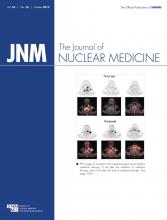TO THE EDITOR: We read with great interest the recent article by Rahbar et al. titled “Differentiation of Malignant and Benign Cardiac Tumors Using 18F-FDG PET/CT” (1). The paper is interesting because diagnosis of cardiac malignancy is difficult and poorly defined. For example, it has been estimated that in most melanoma patients with cardiac metastases, the metastases remain undiagnosed (2). However, several concerns in this paper need to be discussed and clarified.
The first is that special patient preparation is required for detecting cardiac malignancy. It is well known that 18F-FDG uptake in the heart is highly heterogeneous. Fasting for 6 h, as used in the study of Rahbar et al., is not enough to significantly suppress physiologic 18F-FDG uptake of the heart and thus does not offer the ability to differentiate malignancy from physiologic activity (3). We personally examined the 18F-FDG PET/CT images of 27 patients who had fasted overnight (10–14 h), and we found that 18F-FDG uptake in the myocardium (the lateral wall of the left ventricle) varied significantly, with maximum standardized uptake value (SUV) ranging from 2.1 to 27.15 (mean ± SD, 11.22 ± 7.71; with 13/27 having an SUV > 10 and only 8/27 having an SUV < 5), consistent with reports in the literature (3,4). It is likely that the difference between benign and malignant cardiac tumors is less than the variation in myocardial 18F-FDG uptake in healthy persons. To solve this problem, a low-carbohydrate, high-fat, high-protein diet has been proposed in addition to overnight fasting to minimize background 18F-FDG uptake in the myocardium (2,5–7). This diet significantly reduces but still does not allow complete suppression of myocardial 18F-FDG uptake.
The authors performed a receiver-operating-characteristic analysis and obtained cutoff maximum SUVs of 3.5 (with a sensitivity of 100% and specificity of 86%) and 4.6 (with a sensitivity of 94% and specificity of 100%) with high diagnostic accuracy. The authors did not specify for what category the sensitivity and specificity were, and we assume that these sensitivity and specificity values were for identifying malignant cases from a total of benign and malignant cardiac tumor cases. However, these seemingly excellent results are misleading and have limited clinical value. The receiver-operating-characteristic analysis was performed on patients with known cardiac tumors. As such, the sensitivity and specificity obtained in this paper are applicable only to a patient population with known cardiac tumors and cannot be applied to a general patient population or even to patients with suspected cardiac malignancy. Because the prevalence of cardiac malignancy is low in the general patient population, these cutoff SUVs as described in this article would lead to high false-positive results, although use of these criteria in patients highly suspected of having cardiac malignancy is possible and worth further investigation. Even in patients prepared with a low-carbohydrate, high-fat, high-protein diet and overnight fasting, variation in 18F-FDG uptake in the heart remains high. For example, Williams et al. (5) reported a cardiac maximum SUV of 3.9 ± 3.6 (average ± SD) in 60 patients, with 16 patients (26.7%) having a maximum SUV above 4 and 3 patients (5%) having a maximum SUV above 15. The heterogeneity of cardiac 18F-FDG uptake and the low prevalence of cardiac tumors make the accurate detection of cardiac tumors (either benign or malignant) on 18F-FDG PET problematic. More useful would be a receiver-operating-characteristic analysis performed on a patient population representative of clinical practice.
Other causes of increased cardiac 18F-FDG uptake should also be considered. For example, sarcoidosis lesions often have increased 18F-FDG uptake comparable to that of malignancy. With an estimated prevalence of cardiac involvement of at least 25% (8), cardiac sarcoidosis is probably a more common cause of increased uptake in the heart, further complicating the interpretation of an 18F-FDG PET study of the heart. Correlation with the patient’s history and other imaging findings will be critical for accurate diagnosis on 18F-FDG PET.
Finally, the authors did not clarify whether biopsy of heart lesions was performed on all patients and whether biopsy was performed before or after 18F-FDG PET. The authors stated that the grouping of patients was based on “the histologic characterization of the surgically resected cardiac tumors or tumor biopsies.” Apparently, then, the pathologic findings were available for this analysis, which may lead to significant bias in this study.
Footnotes
Published online Aug. 22, 2012.
- © 2012 by the Society of Nuclear Medicine and Molecular Imaging, Inc.







